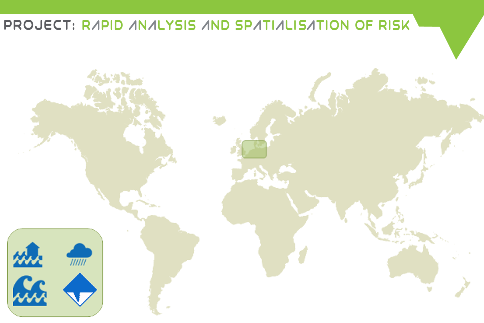
Rotterdam
Risks: Coastal and riverine flooding
Importance: Densely populated, in-situ data required for accurate risk assessment. Validation material available.
Deliverables: Flooding scenarios (coastal, rierine and combined), flooding probability, flood extent, economic quantification
EO Data: DEM, SAR and optical
End Users: Rijkswaterstaat (Ministry of Public Works), OECD
Description
The area of Rotterdam is located in the western part of the Netherlands. Approximately 1.3 million people live in the greater Rotterdam area with an average population density of about 3000 Inhabitants/km2. Housing, industrial and agricultural purposes are the predominant land use.
Rotterdam is situated at the delta of the Rhine and Maas rivers, about 35 km from the North Sea. Due to this location in a deltaic area and an average elevation of about MSL, Rotterdam is a highly flood prone area with a very high flood impact potential. Coastal and riverine floods or combined events are probable. However, large flood protection structures, like the Maeslant Barrier which protects the Rhine Meuse Delta from the North Sea in case of extreme surges and the high protection standards for the Dutch dike.
Within the Rotterdam case study, the following model software has been applied:
• a Rotterdam water levels script to determine the required boundary condition;
• the reliability transformation tool to determine the location and point in time of breaching at potential breach locations;
• the 3D-subgrid software for the two-dimensional hydrodynamic calculations.
Within the dike rings of Pernis and IJsselmonde, 15 dike sections are selected as pote.
Within the dike rings of Pernis and IJsselmonde, 15 dike sections are selected as potential breach locations. The two-dimensional model domain for the hydrodynamic model covers about 500 km2. The resolution of the SubGrid computational elements ranges between 100 and 400 m, according to the local variability of the DEM.
The end-user of the RASOR platform can set the maximum sea water level at Hoek van Holland and the breach locations. One can also set the functioning of the Maeslantbarrier to either ‘functional’ (will close when the water reaches a level of 3.6m at Rotterdam) or ‘non- functional’ (barrier will not close).

RASOR interface for the Rotterdam case study; the user can chose among 15 potential breach points in the area and a maximum water level in Hoak van Holland.

